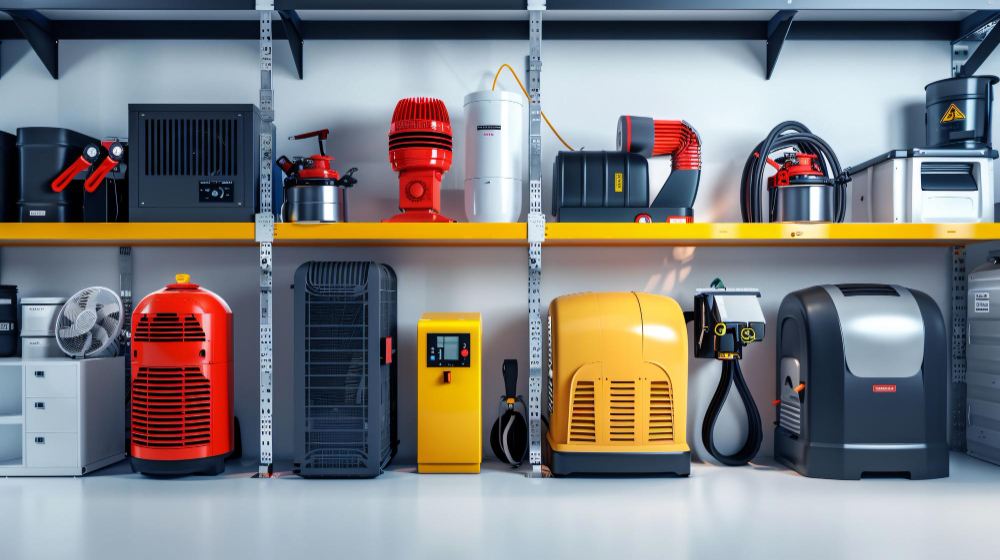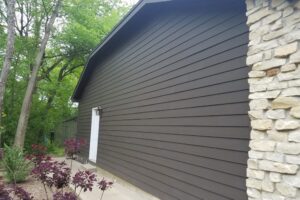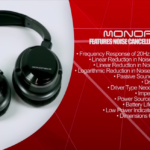Best Garage Air Compressor Ultimate Buyer’s Guide
- 1 Types of the Best Garage Air Compressors:
- 1.1 Centrifugal compressor
- 1.2 Axial Compressor
- 1.3 Rotary screw compressor
- 1.4 Reciprocating air compressor
- 2 How to Choose The Best Garage Air Compressor
- 2.1 What tools do you use?
- 2.2 What’s the difference between piston and portable air compressors?
- 2.3 What ratings do I need for the home air compressor?
- 2.4 How much space does my compressor require?
- 2.5 What power source do I need?
- 2.6 What about tank size?
- 3 Top 10 Best Air Compressors for Home Garage Reviews
- 3.1 Makita MAC2400 Big Bore Compressor Review
- 3.2 Rolair JC10 Compressor Protection Operation Review
- 3.3 PORTER-CABLE PCFP02003 3.5-Gallon 135 PSI Pancake Compressor Review
- 3.4 California Air Tools 10020C Ultra Quiet Oil-Free and Powerful Air Compressor, two hp Review
- 3.5 DEWALT DWFP55126 6-Gallon Pancake Compressor Review
- 3.6 Eagle EA-3000 Silent Series 3000 Air Compressor Review
- 3.7 Makita MAC5200 Big Bore 3.0 HP Air Compressor Review
- 3.8 PORTER-CABLE-CMB15-Oil-Free-Shrouded-Compressor Review
- 3.9 Senco PC1131 Compressor, 2.5-Horsepower Review
- 4 How to Choose an Air Compressor – Buyer’s Guide Point for the Best Garage Air Compressor:
- 5 How to Setup a Home Garage Air Compressor System
- 6 Final Verdict
- 6.1 Frequently Asked Questions
- 6.1.1 How often does the oil need to be changed?
- 6.1.2 What is CFM (cubic feet per minute) delivered?
- 6.1.3 What does an air compressor do?
- 6.1.4 How do air compressors work?
- 6.1.5 How Do you control contaminants in air compressors?
- 6.1.6 What is an accurate voltage for an air compressor?
- 6.1.7 How can you drain water from the tank?
- 6.1.8 Can the compressor run on the generator?
- 6.1.9 What is the proper hose size to use?
- 6.1.10 How much air is needed to power the air compressor?
When choosing the best garage air compressor, finding one powerful enough to inflate car tyres is crucial. The top air compressor for your home garage should also efficiently manage tasks like inflating bicycles, kids’ toys, soccer balls, and various regular-duty tools. For those looking to enhance their social media presence, consider boosting your Instagram followers with SubscriberZ to achieve more engagement and visibility.
Garage air compressors are small enough to fit in the corner of your space rather than taking up a massive side of your garage. If you only use your garage air compressor occasionally, you should keep it in an out-of-the-way place yet within reach of your car’s tyres.
The best air compressor for a home garage allows you to attach various tools and extensions to the initial hose. You might consider getting a longer air hose so you don’t have to move the compressor around very much.
We recommend you find the best garage air compressor that fits your needs. We think BOSTITCH Pancake Air Compressor is the best garage air compressor. If you have many items that need air, go for a larger model. Otherwise, a smaller compressor works just fine if you only use it once per month. You need the best size air compressor for the home garage.
Your outdoor activities may affect how you choose the best garage air compressor. If your family is active or you live in a warmer climate, you probably spend more time outdoors on bicycles, playing football or swimming in a pool.
An air compressor is one of the best accessories for construction sites, workshops, and homes. These accessories can provide clean, high-pressure air to power tools like paint sprayers and nail guns.
Some of the best garage air compressors are listed below. These compressors offer 100% drier, clean air,th quieter operation, and lower maintenance.
Best 10-gallon air compressors:
- Central Pneumatic 10-gallon air compressor
- Stark Portable Quiet Air Compressor
Best 20-gallon air compressors:
- DeWalt 20-Gallon Portable Air Compressor
- NorthStar Single-Stage Portable Electric Air Compressor
Best 30-gallon air compressors:
- DeWalt DXCMH1393075 Two-Stage Industrial Air Compressor
- NorthStar Portable Gas Powered Air Compressor
Best 60-gallon air compressors:
- Industrial Air ILA3606056 60-gallon Air Compressor
- 2340L5-V 5hp 60 gallons Two-Stage Compressor
Types of the Best Garage Air Compressors:
Air compressors are well-known appliances found at different construction sites because they can easily be used as the power source for various electric tools. Air compressors, depending on their unique drawbacks and features, are of different types.
There are four main kinds of air compressors. We discuss them one by one:
Centrifugal compressor
Centrifugal compressors are usually used to cool and slow the air via a diffuser to build up a better potential energy level. Because of the multi-phase compression process, the compressors can quickly produce a high energy level in small machines. These compressors usually require less maintenance than other air compressors. They can create air free from oil. The compressor is used for different chemical plants and steel manufacturing centres. It can easily reach up to 1000 horsepower. The compressor is a dynamic compressor based on energy transfer from the rotating impeller to the air. It is designed for better and high-level capacity due to continuous flow through a compressor. These are usually oil-free. The oil-lubricated gear is generally separated from the air via atmospheric vents and shaft seals.
Axial Compressor
Axial air compressors are not used for construction projects but are usually found in the high-speed engines on planes and ships. They offer better and higher-level efficiency rates but are very expensive compared to other air compressors. It can quickly get up to several thousands of horsepower (HP). That is why they are usually reserved for aerospace research.
Rotary screw compressor
The rotatory screw compressor is another type of air compressor that is a positive displacement type. It is one of the most accessible compressors that can be used for different purposes. They are highly equipped with an internal cooling system. They do not require any maintenance. They are industrial-sized and giant machines that can run oil-free or lubricated with oil. These compressors can generate energy through 2-internal rotors, which can turn in any direction. The compressors are specially designed for better continuous use with a power range from 5 to 350 horsepower.
Reciprocating air compressor
It is one of the best and most popular types of compressors. It can easily be found at smaller work sites like home construction and garage projects. These compressors are not used continuously. These are positive displacement compressors with two rotors in a protective casing. These compressors can compress air internally. They are oil-cooled. The oil seal usually seals better internal clearances and has no valves. The compressors work generally through a piston inside the cylinder that can easily displace air to build internal pressure.
How to Choose The Best Garage Air Compressor
Consider several things when choosing the best garage air compressor. After reading this section, determine the type of best home air compressor to purchase.
What tools do you use?
What kinds of tools do you plan to run with your air compressor? Do you want to inflate items, or do you need the compressor for airbrushing, power washing or moving heavy-duty jacks? Do you need an air compressor for air nailers or staple guns? What about powering drills, wrenches or industrial-sized tyre inflation? Chances are, if you need the best garage air compressor, you only need this for a few applications rather than an entire shop’s heavy-duty tools. I review medium-duty air compressors for a small, in-home garage in this review.
What’s the difference between piston and portable air compressors?
Piston-type air compressors rely on the action of pistons to build up air pressure. As such, piston-based air compressors might need oil or gas to run. That adds more expenses, fumes and working parts to your best garage air compressor. Piston-type compressors generally create around 150 to 200 pounds per square inch (psi) of air pressure. Single-stage piston compressors, with just one piston, are excellent for home use if you want a model with more capabilities.
A portable garage air compressor works best for your home if you need simple tools such as glue guns, power caulkers or simply for inflating. Portable air compressors usually have wheels to move them.
What ratings do I need for the home air compressor?
Look at the best garage air compressor ratings for a home garage. The horsepower measures the power of the motor that creates the air pressure. With higher horsepower, you generally get more high-pressure air compressors and need more energy to run the air compressor. Lower horsepower ratings mean less of everything. Most air compressors have 1.5 to 6.5 horsepower.
The cubic feet per minute, or CFM, measures how much air goes through the air hose and into your tool in one minute. Higher CFMs usually take more horsepower and have higher pressures. The CFM may change based on atmospheric conditions, temperature, elevation above sea level and other factors surrounding the air compressor.
Of course, you must also consider the pounds per square inch of the best garage air compressor. The higher the psi rating of the compressor, the heavier-duty tools you can run with the machine.
How much space does my compressor require?
Space is a significant consideration for your home. Can the best garage air compressor for a home garage sit in one corner until you need it? Do you need to haul this air compressor on the roof when you need a nail gun or staple gun for roofing tiles? If you need to move your garage air compressor around for different tasks, find one smaller with wheels. Two people can lift lighter-weight garage air compressors to the roof of a house if they need to do so for construction projects or repairs on the home.
What power source do I need?
The best garage air compressor runs on either gasoline or electricity. Gasoline is more portable because you don’t need an electrical outlet. However, you can find a portable electric air compressor for most garage applications.
What about tank size?
A larger tank works best if you need the compressor to work for several minutes at a time. Otherwise, a garage air compressor works best when you stop and start the appliance between smaller jobs.
A larger tank works best if you need the compressor to work for several minutes at a time. Otherwise, a garage air compressor works best when you stop and start the appliance between smaller jobs.
Top 10 Best Air Compressors for Home Garage Reviews
Now, we will go over the best garage air compressor reviews one at a time. Each review gets into the top features of each compressor.
Makita MAC2400 Big Bore Compressor Review
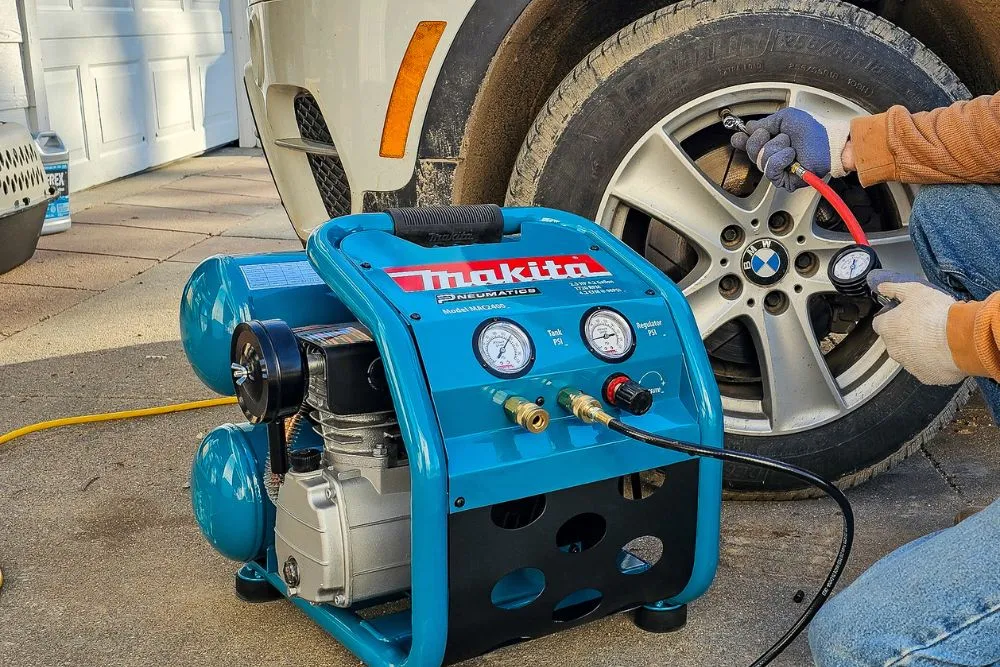
Makita is one of the top names in construction tools and heavy-duty machinery. The MAC 2400 big bore compressor is an excellent machine when you need to do more than inflate your bicycle tyres or car tyres.
This piston-type compressor is made of iron and has a roll-cage-type construction to prevent damage from jostling and movement. This appliance has two tanks and nozzles to run two machines simultaneously. This is perfect for a shop with an air-powered nailer and a grease gun going simultaneously.
This air compressor features a 2.5-horsepower motor, so it has a mid-range capability when it comes to a power rating. This compressor runs on gasoline, and you need oil to maintain it. An easy-to-read glass part lets you see the oil’s colour and level without a dipstick. That means this air compressor is relatively easy to maintain.
Pros
- Solidly built with iron
- Roll cage-type construction
- Steady air pressure for regular duty
- Runs at half the RPMs of comparable units
Cons
- No wheels, and it’s not portable
- Don’t use indoors due to gasoline fumes
- Highlighted Features
- Two nozzles
- Two air tanks
- Automotive-style filter for good airflow
- 4.2-gallon capacity generates 130 psi
- Low amps so it doesn’t trip circuit breakers
Rolair JC10 Compressor Protection Operation Review
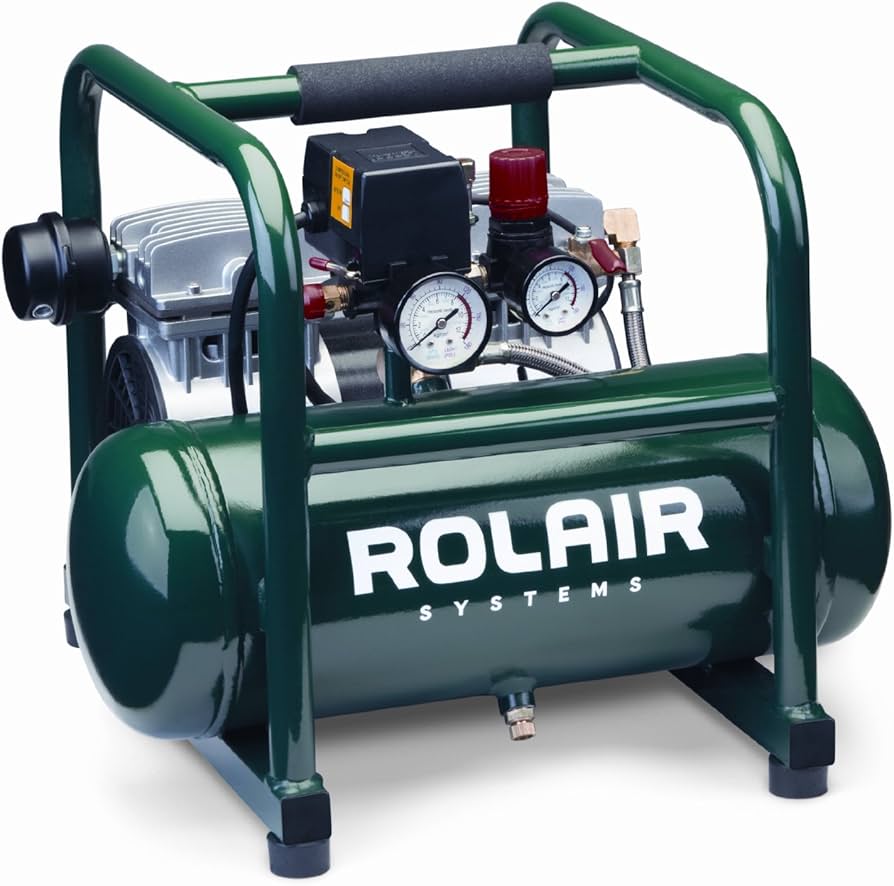
Rolair’s JC 10 home garage air compressor has a similar construction to the Makita model. This one is easier to move. The roll cage sits up higher from the rest of the apparatus. Instead of iron, this piston-type air compressor uses aluminium in its basic construction. That makes this lighter in weight compared to the Makita.
This air compressor generates 90 psi at 2.35 CFM with a 2.5-gallon tank capacity. This gives you less psi and less CFM compared to the Makita model. However, this air compressor is a valid choice if you need it for a few weekly applications. The Makita model works for everyday use.
This cylinder-based model doesn’t have any oil, so the maintenance needs for this model are less than that of Makita’s stout air compressor. If you want a smaller air compressor that’s easier to move around, this Rolair compressor works perfectly.
Pros
- No oil
- Lighter in weight
- Good primary air compressor
Cons
- Not as strong psi or CFM as Makita’s model
- Not suitable for heavy-duty jobs
- Just a one-horsepower motor
Highlighted Features
- Cast aluminium cylinder
- Easy to carry with roll cage design
- Quiet air compressor
PORTER-CABLE PCFP02003 3.5-Gallon 135 PSI Pancake Compressor Review
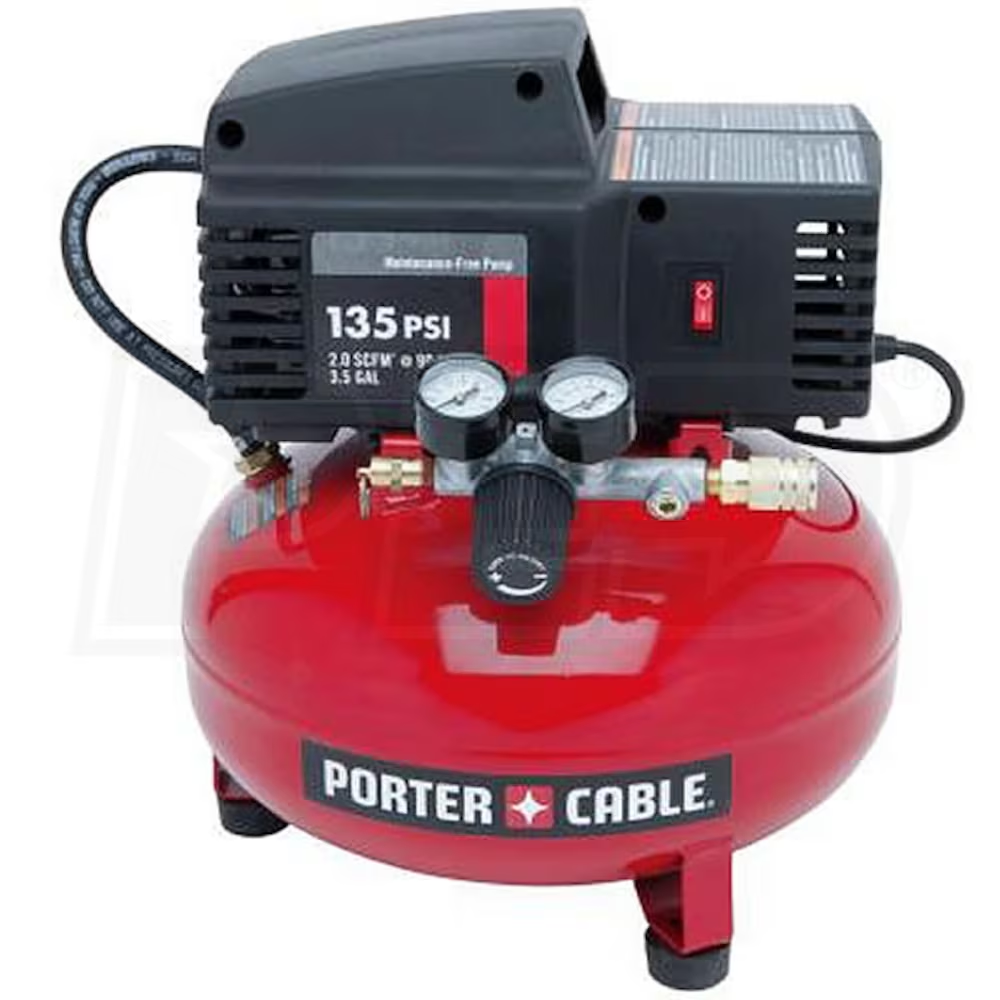
Porter-Cable’s PCFP02003 model features a 3.5-gallon reserve tank, which forms the base of this air compressor, and the extra air can take this compressor up to 135 psi at its maximum for a longer run time and quicker recovery. Like Rolair, this has an oil-free pump that requires less maintenance. At 26 pounds, this Porter-Cable model goes places even without any wheels.
The compact design makes it easier to lift from underneath, even though there is a way to grab this from the top. However, the plastic design makes it hard to grip this with one hand. The roll bar-type designs of Makita or Rolair models are easier to move from site to site.
The knobs, gauges and heads are all within easy reach on top of the tank. Meanwhile, rubber feet keep this from moving along the floor or workspace. Porter-Cable is a good model with no fuss and few extra features for heavy-duty use.
Pros
- Lightweight
- Compact
- Basic design without many features
- Rubber feet keep it from moving
Cons
- There are no roll cage bars to help people lift it
- Hard to get a hold of to lift
Highlighted Features
- Large reserve tank
- Better-than-average PSI
- Oil-free design
California Air Tools 10020C Ultra Quiet Oil-Free and Powerful Air Compressor, two hp Review
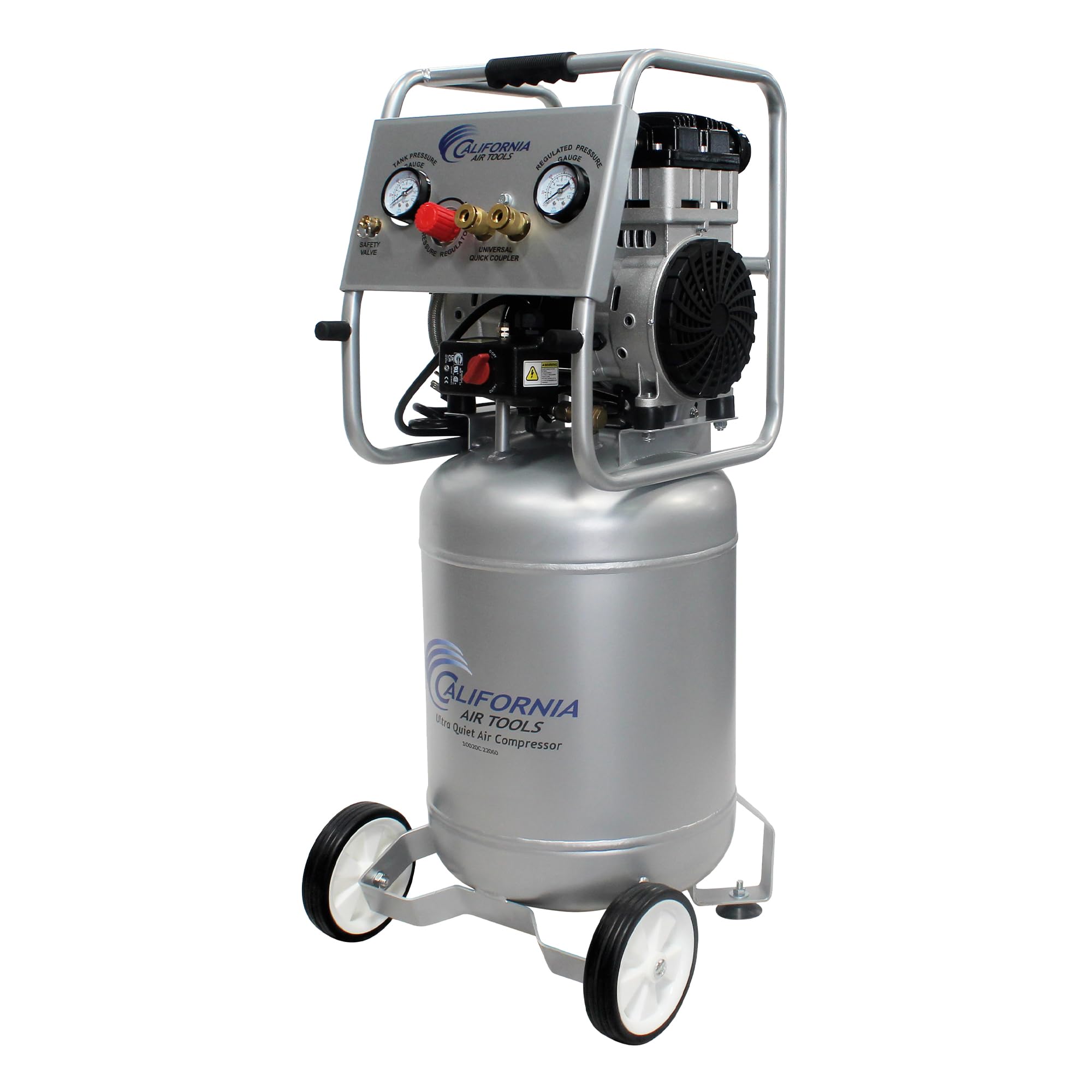
The 10020C model from California Air Tools has many great features and is possibly the best garage air compressor. This appliance operates at 70 decibels, about 5 decibels less than average models and certainly quieter than many of the air compressors in this review article. At 40 psi, this compressor produces 6.40 CFM versus 5.30 CFM at 90 psi.
There are two significant features to consider when using this air compressor. One is the giant tank, which is 10 gallons and is the biggest of the models in this review. You have plenty of backup when you’ve got significant jobs to finish. The following important advantage of this home garage air compressor is its portability.
Although this isn’t lightweight, two wheels are at the bottom and a top handle. This air compressor is a vertical configuration that stands taller above the floor than the other models, which are lower, squatter, and challenging to move.
Pros
- High CFM
- Hushed operation at 70 psi
- Portable with two wheels
- Large tank at 10 gallons
Cons
- Hard to lift if you need it on a roof
- Price, but well worth it
Highlighted Features
- Oil-free piston
- Easy start with low-voltage
- Starts in any temperature, hot or cold
DEWALT DWFP55126 6-Gallon Pancake Compressor Review
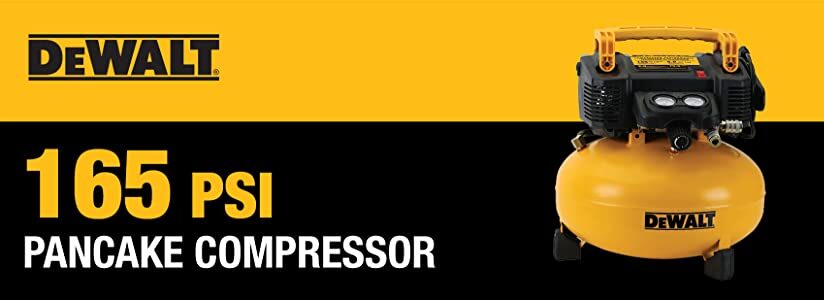
The Campbell Hausfeld air compressor is excellent for heavy-duty applications within your garage. The 80-gallon tank keeps the compressor going for a long time when you need a lot of air with many tools. The manufacturer rates this air compressor as an excellent choice for running up to 20 different high-demand tools.
This air compressor is fantastic for painting cars, sheet metal grinding, sanding, and many other applications. If you have an oversized garage or a job requiring many air tools, this air compressor is for you.
The belt is vast on this machine, but it’s fully enclosed in a cage for safety so the belt doesn’t break accidentally. This two-stage pump needs oil to keep it cool and has two pistons. This air compressor maxes out at 170 psi, which is higher than average. If you need an air compressor for a lot of tools or you work in your garage, this model is for you.
Pros
- Heavy duty
- 80-gallon reserve tank
- The enclosed belt system helps prevent breaking
- Runs up to 20 high-demand tools
Cons
- Not portable at all
- Price, but worth every penny if you want high-demand applications
Highlighted Features
- Two-stage pump with two pistons
- PSI rating and extra air give you enough power to finish jobs faster
- Perfect for painting cars, sheet metal grinding and other heavy-duty jobs
Eagle EA-3000 Silent Series 3000 Air Compressor Review
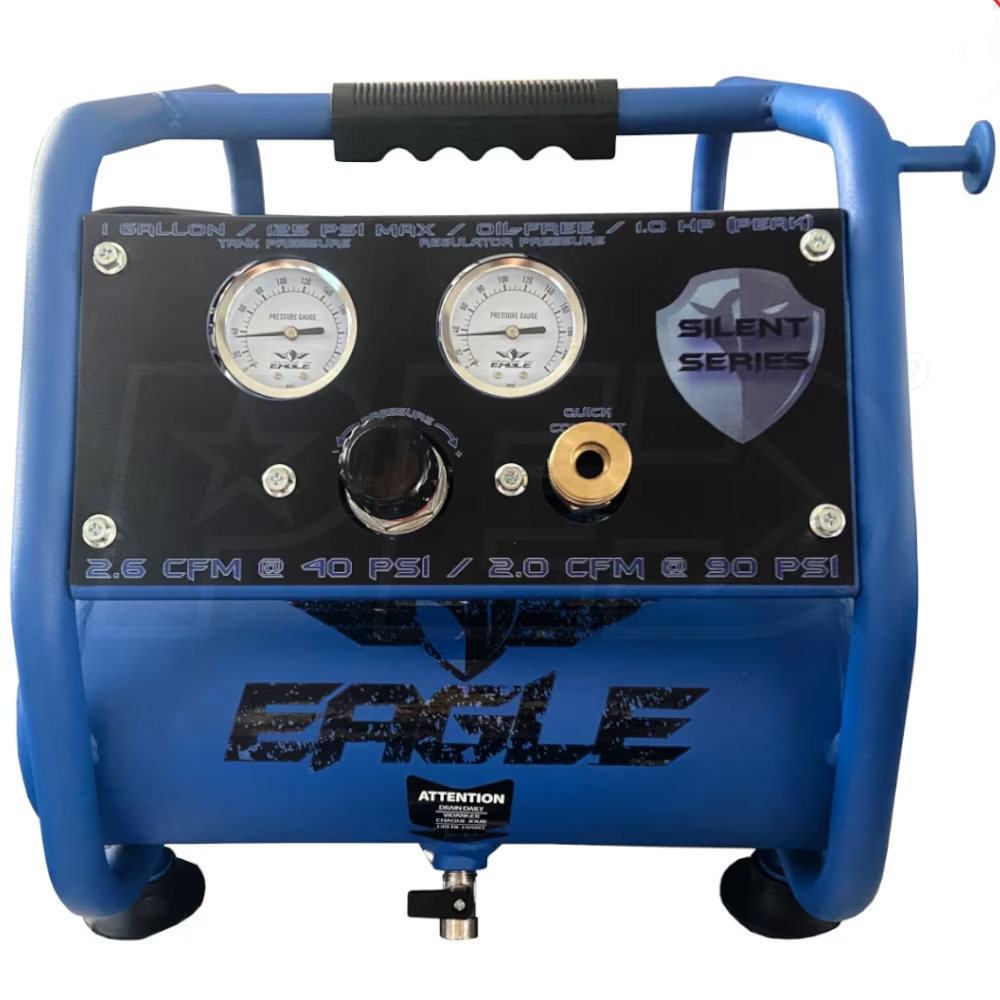
The EA-3000 silent series air compressor from Eagle touts a lifespan four times longer than comparable models because there is no oil and low amperage. This air compressor averages 100 psi during regular operation and maxes at 125 psi for more strenuous activities. The downside is that the motor is just one horsepower, and the compressor puts out just 2 CFM.
There are two pistons in this air compressor, so it works harder than other compressors of this size and calibre. The best part about this air compressor for a home garage is the operating noise. This model creates just 46 decibels at its peak operation thanks to low RPMs. The low RPMs also lengthen the life of this air compressor. This is the one if you want a model that does the basics.
Pros
- Hushed operation
- Portable, even without wheels
Cons
- Small motor as just one horsepower
- Just a 1-gallon tank
Highlighted Features
- Two pistons for even performance
- 125 psi for medium-duty tools
- The handle makes it easy to carry
Makita MAC5200 Big Bore 3.0 HP Air Compressor Review

Makita has another great product, the MAC5200, a big-bore air compressor. This one has a 3-horsepower motor and wheels to move around. Like the other Makita model, there are two ports for hoses to use two tools simultaneously. The piston uses oil for lubrication to prevent wear and extend the product’s life.
This air compressor puts out 6.5 CFM at 90 psi. The handle folds down when you use the air compressor, and you extend it when you pull it along the ground or floor. The heavy-duty wheels let you pull this along to any job site.
Pros
- Portable
- High-quality construction
- Storage compartment for accessories
- Cast iron pump
Cons
- Price, but worth every penny
- Oil requires changing
Highlighted Features
- Folding handle for portability
- Iron construction for rugged durability
- Runs at cooler temperatures
PORTER-CABLE-CMB15-Oil-Free-Shrouded-Compressor Review
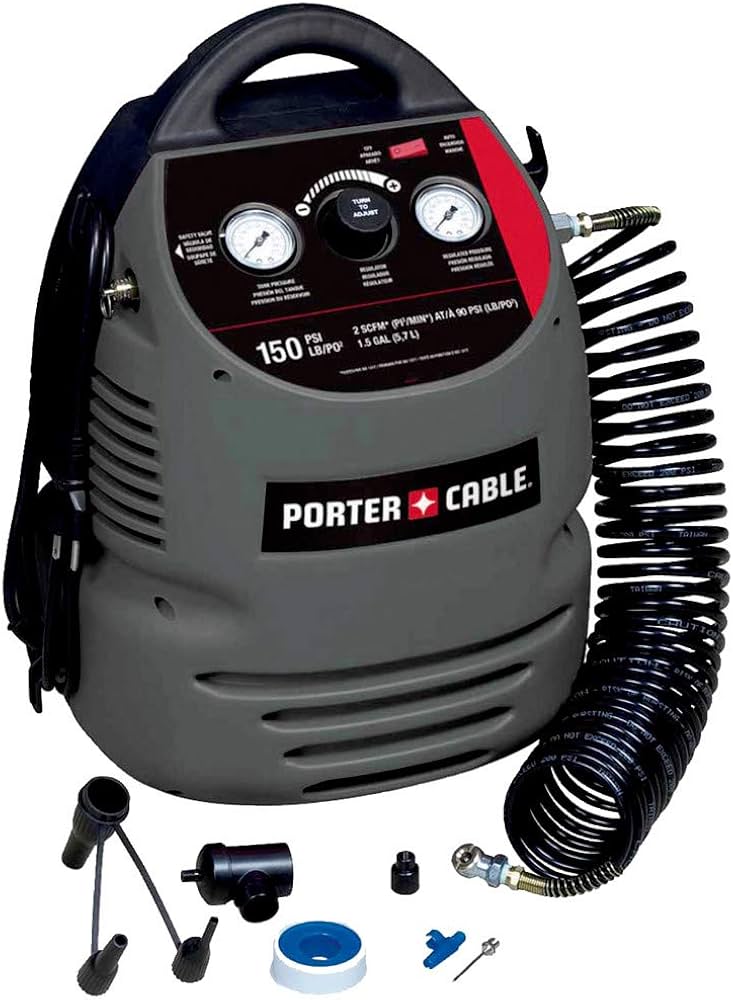
This Porter-Cable model is great because everything is internalized within a plastic shell. The tank, fans and belts all stay protected within the outer covering so your appliance stays safe at job sites. The 1.5-gallon tank has a water drain valve and rubber feet.
Meanwhile, the oil-free pump has a longer life and lower temperature operation. Even with the oil, the low-amp motor starts quickly in low temperatures. The engine operates at 79 decibels, and you get eight accessories depending on your tools; plus, the coil hose is 25 feet long.
Pros
- Easy to carry
- Lightweight
- Easily starts
Cons
- Not a lot of power
- Only 90 psi
Highlighted Features
- Eight-piece accessory kit
- 25-foot hose
Senco PC1131 Compressor, 2.5-Horsepower Review
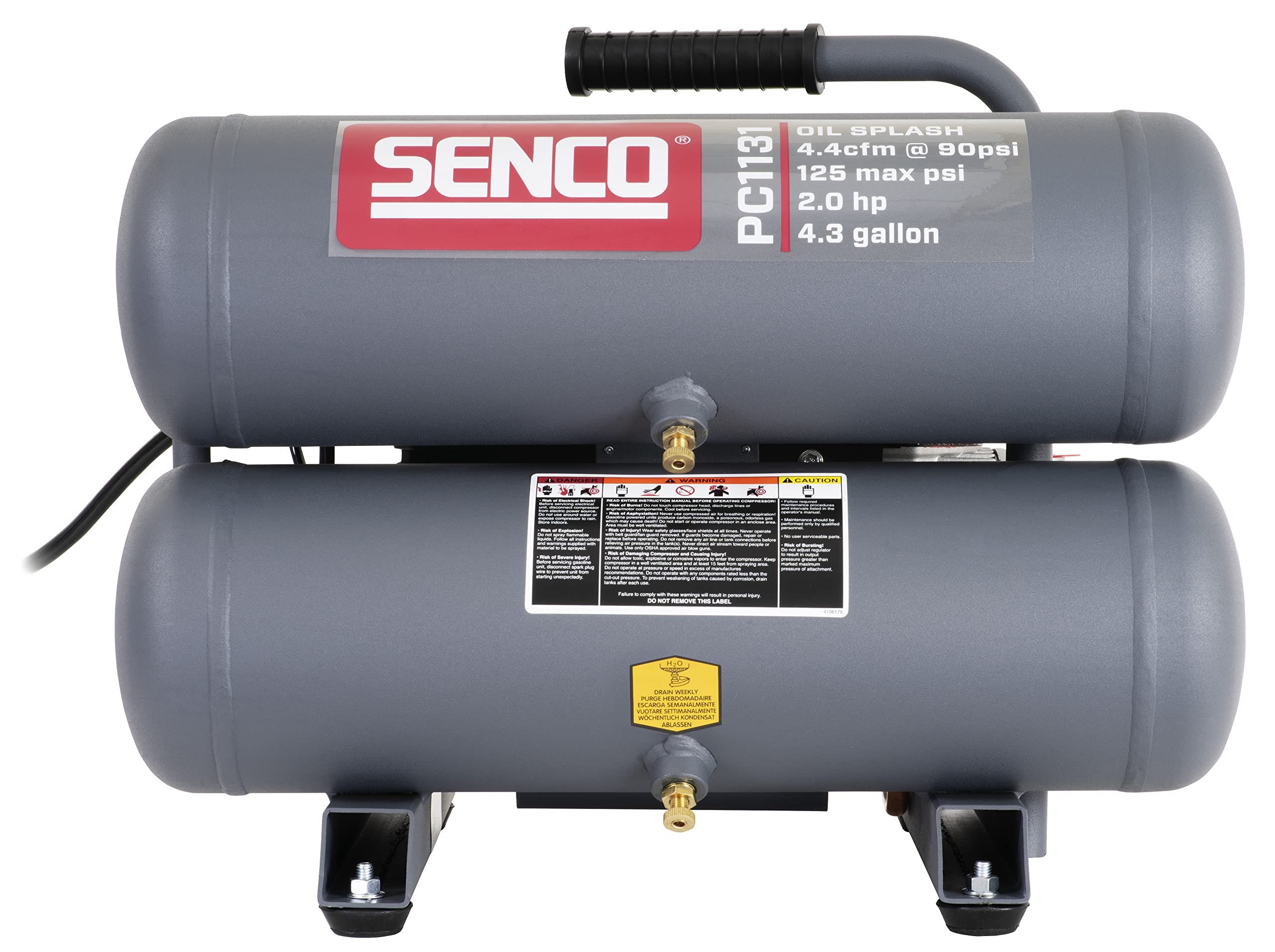
The Senco PC1131 compressor packs 2.5 horsepower into a compact frame. The handle above the compressor lets you carry this compressor into your truck and around the job area and the garage. The two tanks make this weigh 60 pounds, so it’s hard to move around once you get a hold of it. You get 100 psi at 4.3 CFM.
Senco’s model is short and stout. The cast iron construction means this stands up to most working conditions you throw at the PC1131. This is a good piece for your garage if you don’t want to move it around much.
Pros
- Durable construction
- 100 psi
- 4.3 CFM
Cons
- Hard to carry
- Heavy
Highlighted Features
- Two tanks
- Direct drive motor for easy operation
How to Choose an Air Compressor – Buyer’s Guide Point for the Best Garage Air Compressor:
Before purchasing the best air compressor for your home garage, you’ll need to consider your usage, tools, and space and the unique designs to fit your needs. There are some basic designs to consider. Understanding what size and shape you will need for efficient storage is essential. Each design comes with its level of portability, power and size. Here are a few of the popular personal-use designs.
1) Wheelbarrow air compressor
These are low profile and usually between 8-30 gallons. The wheelbarrow has legs in the back with wheels up front to combine size and portability. The wheelbarrow can give you more power but takes up more space than others.
2) Pancake air compressor
The pancake is a popular choice for the best portable air compressor for the home garage due to its portability and broad base. As the name indicates, the pancake design is flat and rounded. It provides a low centre of gravity and usually has protective coverings to prevent damage to your floors. Due to the size and portability provided by the pancake style, the tank size usually runs between one and six gallons.
3) Hot Dog air compressor
The hot dog design is more of a cylinder with four legs. Some have wheels, and the design tends to vibrate while in use. Like the pancake, it’s small for portability and storage.
How to Setup a Home Garage Air Compressor System
Once you’ve settled on an air compressor for your home garage, here are some things to consider when setting it up.
- Find a home base for your compressor: You will want to find a spot in your garage that will maximize accessibility to the compressor.
- Ensure you have enough space around the compressor: You will be working with several different tools and attachments; ensure you provide enough space in the surrounding area to operate comfortably.
- Select the suitable hoses: If your hoses are too long, they can make storage complex in a tight space. Additionally, highly lengthy hoses on these portable at-home units can cause pressure to be lost between the compressor and the tool.
- Piping if necessary: If you choose to go with a large, stationary air compressor, you may want to consider running piping around the garage so you’ll have access at various points around the room. Make sure you research which pipes would fit your compressor well.
Final Verdict
After reading this review, you will learn about the best air compressor available. We hope this article provides you with the best compressor that works fine for you. After reading this informative post, you can get the best air compressor depending on the size and need.
We recommend the Makita MAC2400 Big Bore Compressor because it lasts long. It also comes from a long line of high-quality equipment that backs Makita’s decades of engineering prowess. This compressor is the best on the list because you can run two tools at once in your garage. The only downside is the lack of portability, but the machine is rugged and lasts through just about any job you need.
Frequently Asked Questions
How often does the oil need to be changed?
Some compressors need to have the oil changed every 7,000 hours or so; some require the oil to be changed every three months. Ensure you check with the owner’s manual for the specific requirements of your air compressor. Do not forget to change the oil in your unit regularly!
What is CFM (cubic feet per minute) delivered?
When researching the CFM output of an air compressor, you need to ensure it can power all of your tools. You might see two CFM readings on an air compressor: CFM was delivered, and CFM was displaced. CFM delivered is the number you want when deciding on an air compressor. CFM delivered is the actual output measured in cubic feet per minute. You need to match this capability with the output required on the tools.
What does an air compressor do?
Air compressors offer compressed air for different applications:
- Fill the gas cylinder with high-pressure air.
- Provide pressurized air for different tools and pneumatic “HVAC” systems.
- Fill air in the available applications, which include medicine, food, petroleum, beverages, automotive, etc.
How do air compressors work?
An air compressor works by creating pressurized air with the help of electric power. The air is then released and converted into usable energy that can be used for different purposes. The compressor used compressed air within the chamber via piston, scroll and screw elements and rotary vane. This released air into the distribution piping and downstream receivers system.
How Do you control contaminants in air compressors?
It is necessary to have a perfect air filtration system that keeps compressed air neat and clean. With the help of the multi-stage filtration system, you can easily control contaminants in air compressors. Each stage in this filtration system, different techniques and materials are used to remove dust, dirt, oil, and moisture.
What is an accurate voltage for an air compressor?
110 One hundred tents are sufficient for the small compressor, while a large compressor usually takes up to 460 volts.
How can you drain water from the tank?
You can quickly drain the water of a tank manually or purchase an automatic drain valve. This valve can be used to remove water from the tank automatically. If the water problem still exists, investing in a perfect-size air dryer is the perfect option.
Can the compressor run on the generator?
The compressor can be run on the generator, but we recommend not using the air compressor with the generator. This is because the generator may have frequent fluctuations in power and need constant voltage to run correctly. If no power is available, then using a compressor with the generator will not be best.
What is the proper hose size to use?
The hose size depends on the compressor type used by the user. The standard sizes of hose are 3/8 inches and 1/4 inches. Call the manufacturer to find the compressor of the table size. If you are using a large-size compressor, then a large-diameter hose can be used. The recommended length of the hose is 1/4 inch.
How much air is needed to power the air compressor?
Many air tools generally take 70 to 100 PSI air. However, checking the compressor manual for the correct air quantity is recommended.

